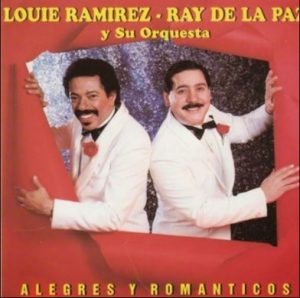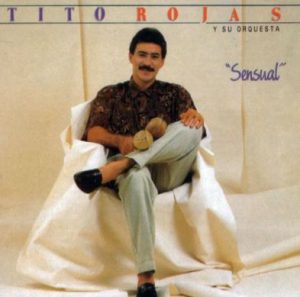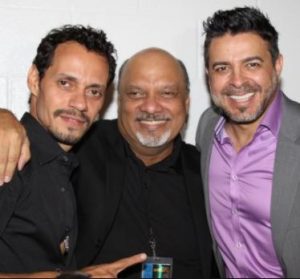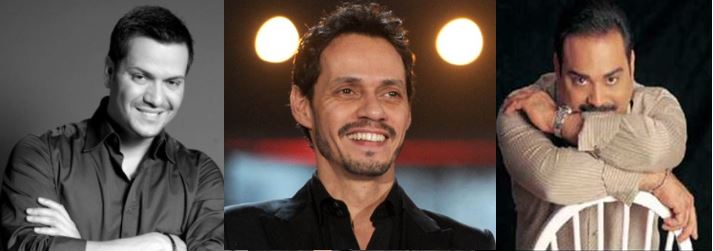Salsa survived the Rock and Disco boom of the ’80s by evolving into a more orchestrated, softer, and therefore more mainstream type of music. Salsa Romántica was the next step in that softness trend.
However, for Salsa to survive through the ’90s, it had to compete with the rebirth of Merengue.
Some First Steps Towards Salsa Romántica
Salsa was able to get through the huge popularity MTV gave to Rock and Pop in the 1980s. Its evolution into a more mainstream sound helped to elevate its popularity among “non-salseros”. This trend continued to evolve into a new trend of Salsa that focused on romantic songs. As a result, this trend was later baptized “Salsa Romántica” (romantic Salsa).
The early ’80s became particularly difficult for Salsa artists. But by the mid-80s, some Salsa artists figured that what was grabbing the public preference was not just the smooth tempo of using smoother mambos, with fewer “descargas” (solos) on the songs. It was also important to the message the songs carried. Salsa songs that attracted the mainstream audience, like Ruben Blades’ “Sin Tu Cariño” (1978) were really romantic songs.
However, there weren’t enough songwriters like Ruben Blades to go around composing romantic songs for everyone. Therefore, Salsa artists began converting popular ballads into Salsa. Dipping into the Latin American ballad songs provided a huge inventory of romantic songs.
The Birth of Salsa Romántica
The mid-80s saw some established hard-core Salsa artists quickly catch into converting romantic ballads into Salsa songs. Years before, several artists had converted individual pop or even ballad songs into a more tropical or even salsa rhythm.

However, Louie Ramirez was the first one to make a Salsa Romántica album when he was commissioned the work for the K-tel label.
K-tel wanted to penetrate the Spaniard market with Salsa and assigned Ramirez the task of producing the album by arranging popular ballads by Spaniard authors into Salsa. Louie Ramirez took songs written by Manuel Alejandro, Camilo Sesto, and Miguel Bose among others, and converted them to salsa. He hired young singers Ray de la Paz and Johnny Rivera to sing them.
In 1982, the first Salsa Romántica album was launched, and titled “Noche Caliente”. It was a smash hit with songs like “Estar Enamorado” and “Todo se Derrumbo”.
Alertly, veteran bandleaders like Tommy Olivencia, used his new singer Frankie Ruiz in this new format. They delivered the hits “Como Una Estrella” (1983), and the Jose Jose classic “Lo Dudo” (1984), also written by Manuel Alejandro. Louie Ramirez followed up with more albums in this new style. This resulted in hits like “Yo Soy Aquel” (1984) and “Ladron de tu Amor” (1985), with Ray de la Paz.
The Boom of Salsa Romántica
This younger generation of Latinos found Salsa Romántica more relevant to their situation. Its message was in sharp contrast to the protesting/rebellious years of the 60s or the urban themes of the 70s. These things were now a far and faint memory that didn’t resonate with them. But with hormones in full swing, Salsa Romántica was the thing.
Salsa Romántica had the peculiarity that its emphasis was on the singer, the romantic songs they picked, and the arrangements. Therefore, established singers began to leave the orchestras they were with to pursue solo careers.
Frankie Ruiz, Gilberto Santa Rosa Go Solo
One of the first ones was Frankie Ruiz, who left Tommy Olivencia in 1985. Frankie released his album “Solista…pero no Solo” (1985) which became a huge hit. It included the converted balladas “Esta Cobardía” and the José José famous “Tu Con El”. It also included the Roberto Carlos song “El Camionero”. All were huge hits.
Gilberto Santa Rosa also decided to go solo in 1986. Trained in the Salsa Clásica school with bandleaders Mario Ortiz, Tommy Olivencia, and Willie Rosario, he decided to jump into the Salsa Romántica growing wave. He immediately delivered the hits “Sin Un Amor” (1986), “Dejame Sentirte” (1988), and “Vivir Sin Ella” (1990).
Other Salsa Clasica Singers Join Salsa Romántica
Additionally, established classic Salsa artists like Andy Montañez, Willie Colon, Tito Nieves, Jose Alberto “El Canario”, Tito Rojas, and Oscar D’Leon would also jump in the Salsa Romántica wave.

Lalo Rodriguez, who gained fame with Eddie Palmieri and Tommy Oliviencia in the ’70s, had gone solo since 1980. Besides the success of his 1st solo album “Simplemente Lalo” (1980), he had not been able to attain success until converting to Salsa Romántica. His album “Un Nuevo Despertar” (1988) contained the hit “Ven Devorame Otra Vez” one of the biggest all-time hits of Salsa Romántica.
Even El Gran Combo jumped in the Salsa Romántica wave. They released the albums “Romántico y Sabroso” (1988) and “Amame” (1989). They would continue with the Salsa Romántica themes through the 90s with mixed results.
[Note: for more on the history of El Gran Combo during this period you can read my blogs “The 80’s” HERE and “The 90’s” HERE.]
New Breed of Salsa Romántica Singers
With the concept firmly established, newcomers to Salsa quickly jumped in. Producers began to look for young, good-looking singers with good voices. They needed to be good singers, not good “soneros”. This gave birth to a new breed of Salsa singers.
One of the first ones was Eddie Santiago who released “Atrevido y Diferente” (1986). This album included the hits “Tu Me Quemas” and “Que Locura Enamorarme de Ti”, both huge hits. He followed that album with “Sigo Atrevido” (1987). It contained the mega-hit “Lluvia”. The “atrevido” (daring) theme comes from the somewhat explicit sexual lyrics in the songs. Reggaeton would take explicit to the next level in the 2000s.
Nicaraguan musician and singer Luis Enrique, used his talent and good looks to gain a huge following. He released “Amor y Alegria” (1988) and “Mi Mundo” (1989). Both albums were mega-hits.
Victor Manuelle, Marc Anthony, and Jerry Rivera were other notable newcomers to Salsa Romántica. All were young, good-looking, and good singers and would have a huge impact in the ’90s.
Jerry Rivera, the “Cara de Niño”
Jerry Rivera was the first of the group to try his luck in Salsa Romántica. After a lackluster debut album, his sophomore album “Abriendo Puertas” (1990) was a huge success. It contained the hits “Esa Niña”, “Dime”, and “Nada Sin Ti”.
His next album “Cuenta Conmigo” was lifted by the Omar Alfanno mega-hit “Amores Como el Nuestro”. He followed that up with “Cara de Niño” (1993) which included “Que Hay de Malo” and “Cara de Niño”. Those strings of hits established Jerry Rivera as a true force in Salsa Romántica.
Marc Anthony Swims “Contra la Corriente”
Marc Anthony and Victor Manuelle entered the Salsa Romántica scene in 1993. In New York, Marc Anthony had lackluster luck in freestyle music in English. He had rejected an offer to record Salsa in Spanish. One day he heard Juan Gabriel’s “Hasta Que Te Conocí” in a taxi and decided he would like to record it in a Salsa version. The song was included in his 1st Spanish recording “Otra Nota” (1993) and became a huge hit.
This opened the door for follow-up albums “Todo A Su Tiempo” (1995) and “Contra La Corriente” (1997). With mega-hits from Omar Alfanno’s pen like “Te Conozco Bien”, “Y Hugo Alguien”, and “Contra La Corriente”, Marc Anthony became a Latin music mega star.
Victor Manuelle, the “Sonero de la Juventud”
In Puerto Rico, Gilberto Santa Rosa had discovered the talent of the young Victor Manuelle. After his first album “Justo A Tiempo” (1993), he started to accumulate hits with “Solo Contigo” (1994). This 2nd album included the hit “Apiadate de Mi”.
Victor Manuelle’s next album, self-titled “Victor Manuelle” (1996) hit it big with “Hay Que Poner el Alma” and “Volveras”. Both songs reached #1 in the Billboard Latin Tropical Airplay list. From there, Victor Manuelle has continued to deliver a string of mega-hits that converted him into one of the main stars of Latin music.
Source of Songs: Old Ballads & New Songwriters
Romantic ballads were the source of most Salsa Romántica songs during their early stages. However, as the movement took flight, new songwriters began to fill the demand for romantic themes. Two of the most prominent ones were Panamanian Omar Alfanno and Cuban Jorge Luis Piloto.
Omar Alfanno Romantic Stories
One of the most influential songwriters in the Salsa Romantica movement has been Omar Alfanno. He gave up a career as a singer-songwriter, to focus on songwriting. This turned out to be a great move.

Omar began his career as a singer-songwriter in the late 80s. The Panamanian musician also had studied a professional career as a dental surgeon. Nonetheless, he gave it up on his love for music. I say “also” because it’s well known that fellow Panamanian singer-songwriter Ruben Blades gave up a career in law to pursue his musical interests.
Salsa Romantica was booming in the late 80s, and Omar Alfanno felt he had an opportunity in it. He recorded 4 albums between 1987 and 1991. None were commercial mega-successes, buy did ok.
By the mid-90s he again began to write for other singers. He had done this while studying dentistry in Mexico during the ’70s. At that time he had artists like Lucero, Ana Gabriel, Yuri, and Vicky Carr sing his songs.
To this day, Omar Alfanno considers himself a songwriter of ballads and Latin pop. It just happens that his songs were taken to the Salsa beat. One of his first hits in Salsa was “El Gran Varon” (1988), performed by Willie Colon. This song put him again on the map as a songwriter and opened the door to a barrage of hits.
Alfanno’s songs began to be solicited and recorded by Marc Anthony, Gilberto Santa Rosa, Victor Manuelle, Jerry Rivera, Luis Enrique, and Tony Vega among many others. His songs began winning awards, and so did he. Omar won at least 8 songwriter awards for his songs.
Jorge Luis Piloto, Latin Music Songwriter
The Cuban-born and Miami resident Jorge Luis Piloto has been a songwriter for many years. He writes romantic songs, but these are not limited to the Salsa genre. His songs are performed by Merengue and Latin pop artists as well.
Jorge Luis has written over 500 songs, and like Alfanno, he wrote ballads and pop songs, not Salsa. When he first heard one of his songs converted to Salsa Romantica, he was a bit offended. However, eventually he got used to the idea and began to write some songs specifically for this genre.
His songs have been made popular by Salsa artists like Gilberto Santa Rosa, Rey Ruiz, Luis Enrique, and Jerry Rivera. Merengue star Olga Tañon has also recorded him. In addition, his songs have been popularized by Latin pop stars Chayanne, Jose Jose, Lourdes Robles, and Yolandita Monje.
Here’s a short interview with the Cuban songwriter.
Next: Surviving Merengue
Salsa Romántica came to rescue Salsa from commercial ruin. The romantic themes with smooth arrangements were a huge hit. They avoided solos and complicated “mambos”. Instead, they focused on a solid but simple “tumbao”, with emphasis on the singer, just like in ballads and pop. New and younger Salsa fans that didn’t grow with the 1970’s hard-core salsa, loved it.
However, these younger Latino fans were also been attracted by a new style of Merengue. The new merengue borrowed from Salsa romantic themes was easier to dance to, and the music was festive. In the next part of this series, we’ll see how the new romantic and more contemporary sound of merengue was born. We’ll discuss its new stars, and the stiff competition it presented to Salsa music.


[…] me, Anthony’s voice and singing style are well-suited for Salsa Romantica. El Gran Combo is using him mostly for romantic songs. Anthony does have a good sense of clave in […]
[…] 1990s are hard to explain. Ithier and the rest of the combo did all they could to ride the wave of Salsa Romántica. The success in this genre was evasive to them. Ithier tried new arrangers, new producers, new […]
[…] and a strong closing with “Amame“. This gave them a confidence boost for facing the Salsa Romántica challenge heading into the […]
[…] a vital part of Salsa during its golden age of the 60s through the 80s. But by the ’90s when Salsa Romantica became prominent, they were […]
[…] albums. I would point out the first “Dueno del Soneo” (1989) album, where he goes into Salsa Romantica, but does it in great fashion. However, none of his other solo albums were par to “Bobby […]
[…] could be hard for some to comprehend that last statement because the music produced during the Salsa Romantica era and afterward doubled-down on that formulaic and “overproduced” sound. It basically […]